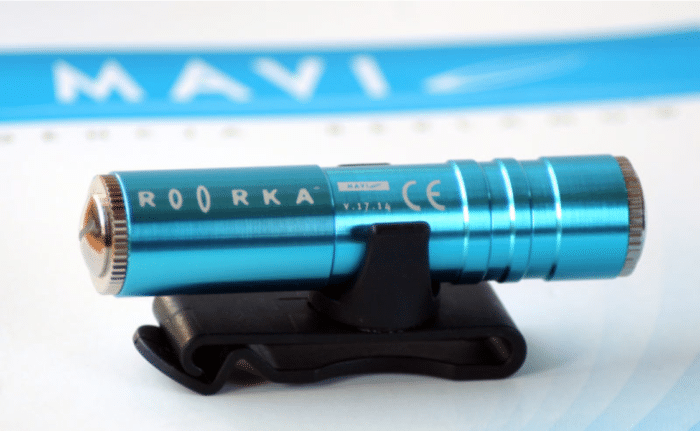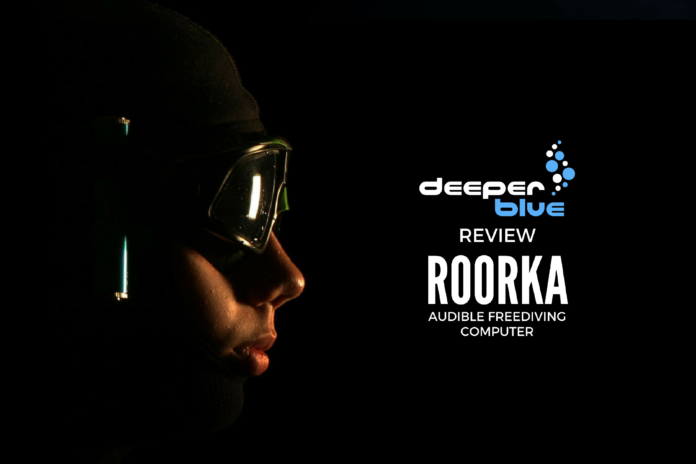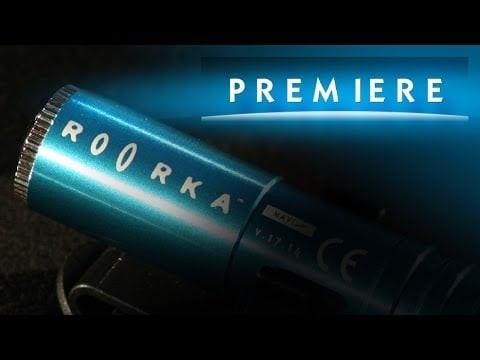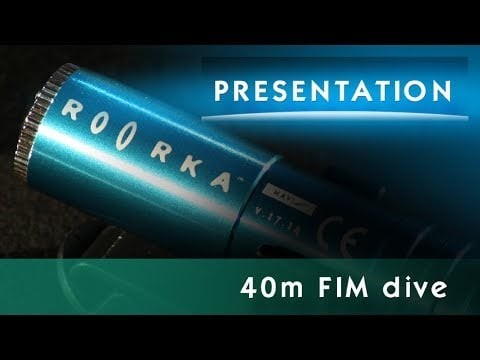Innovation is one of the hallmarks of our species, taking us from horse and carts to the moon. Sometimes innovation comes from new materials and improving old designs, and sometimes innovation seems to take a jump sideways to show us a new solution altogether that most of us would never have thought of.
For me, freediving is a unique exploration of the ancient and the modern. We use our bodies, shaped by millions of years of evolution, and maximise the mammalian dive reflex to take us deeper than ever thought possible, yet we also use modern technology to take us there with neoprene suits, fluid goggles, nose-clips, monofins, and sleds.

With freediving computers, the most tech part of our equipment, the emphasis has always been on the visual. We see our depth, time, surface interval and so on. A deep freedive, however, is not the same as a scuba dive. On any dive where you are breathing underwater, you have to focus your attention outwards, keeping an eye in real time on your computer and equipment. A visual display of information is critical to this as there are lots of pieces of information that need simultaneous attention. A deep freedive is more of an internal journey. We don’t want to break our streamlining or concentration by constantly bringing our computer up to your face. The deeper you go, the darker it gets, and this also hampers our ability to read a small screen.
We also need to know when to perform a mouthfill, when the bottom is approaching without having to crane our necks to look, and when other depths are reached to take our foot off the gas. Freediving computers have sought to help overcome this by the use of depth alarms that can be customised to go off at different depths. However usually only two alarms are available and I have seen on many occasions, the freediver miss them because they can’t hear them go off. A solution has been to put the computer around a neck weight or in the hood, but this is hardly an ideal solution.
The inventors of the Roorka have seen these limitations and come up with a freediving computer unlike any other you will have seen or experienced. The Roorka has no display, no wristband, no light. Instead, the Roorka talks to you…
This to me is genius! You put it on (more of that later), do your dive, and it will tell you pretty much everything you need to know when you need to know it. It is infinitely customizable, meaning that you can decide exactly what you want it to say and when a trait that sadly doesn’t apply humans.
So, let’s start with the size. It’s small, nine and a half centimeters long, and weighs approximately 66 grams. It also comes in a custom built a padded box with clips to fit it to your mask. The Roorka can be worn via the clip on your mask strap (make sure you have it on the inside of the strap or easily tucked inside your hood).

I found that the most comfortable way to wear it was in my hood, under my jaw. We tested it in fresh water at Vobster Quay during RAID Freediver and RAID Master courses, and also in the Red Sea on an advanced course. Unfortunately, when the Roorka was being transferred from one student to another during the first water trials, the clip pinged off and disappeared into the dark silty depths of the lake, never to be seen again. It was only thanks to the speedy finning of one of our instructors, Zoe, that the Roorka itself didn’t join it. With the Roorka being an expensive bit of kit, I would recommend that unless you are brave, and maybe also bungy cord the Roorka to your mask strap, you always wear it in your hood.
The voice that team Roorka has selected is also easy on the ear, that of a well-spoken female. Her voice is evenly modulated and easy to understand (she speaks English). It may be possible in the future to customise the voice, something my students suggested, so they could have my voice in their ears at all times, berating them for the quality of their duck dives…
When we first used it, it had standard settings, which meant it told you everything. And I mean everything. Every meter, every duration, the water temperature, the stats from each dive, your inside leg measurement. However, I then started watching the informative video tutorials made by the Roorka team and also via a Skype call so I could better understand how to set it up and customise it.
Customizing For The Tech Non-Savvy
Here I must insert a full disclosure.
I am not tech savvy. I mean, really really not tech savvy. I don’t do Excel, I don’t do programming. My internet browser currently has 17 tabs open and this for me is a miracle as there are usually around fifty at any given point. I don’t ever turn my computer off and the memory is currently full and I don’t know how to fix it. The point is, to get the most out of the Roorka you need to have a brain that works in an orderly fashion. The things that make the Roorka so incredible, are also the things that make my brain hurt.
So let’s see just how customisable the Roorka is.
You can set the salinity of the water for uber accurate depth measurements, you can set depth and time measurements under the water and above. You can get it to tell you to mouth fill, relax, slow down, breathe, take your mask/googles/nose-clip/facial equipment off, give the OK signal, say ‘I’m okay’, water temperature. You can set the speaker volume.
All in all, there are approximately 70 customisable alerts which take us light years ahead of a traditional dive computer with two beeps.
You can also set up when a particular program starts. So, for example, you can set that the timer goes off when the Roorka goes to 30cm of depth. So it can be used for static. It can also be used in the same way for dynamic. So, for example, it can be used for dynamic training tables, telling you when to swim and when to breathe and for how long.
And you can have as many different programmes as you like. Once you create one, you save it and download it easily to your Roorka. It also has a very handy simulation mode in the software so you can test in real time your dive and alerts. This simulation can also be sped up or slowed down if you want to check a lot of info, or if impatient like me.
Customisation – What I asked for
So after our first trials and a long Skype call, I asked the designer of the Roorka to write me a programme based on exactly what I wanted. I wanted settings that could be used for students doing skills and checking buoyancy, and also for me to time a breathe-down and how long a student had been down for buddying purposes.
Alerts at
- 5m (going down)
- 10m (whether going up or down – for buoyancy checks and skills)
- 11m (whether going up or down – for buoyancy checks)
- 12m (whether going up or down – for buoyancy checks)
- 15m (whether going up or down – for skills)
- 20m (whether going up or down – for skills)
- 24m (on way down, say ‘do mouthfill’)
- 25m (whether going up or down )
- 30m (whether going up or down)
- 35m (whether going up or down)
- 40m (whether going up or down)
- when the deepest point of the dive has been reached, say what depth it is. so for example, the diver turns at 32m, when they turn they are told how deep they have gone)
On Ascent
- at 9m – swim slower
- at 4m relax yourself
- at the surface – breath! breathe! breathe! for 12 seconds
Deeper than 5m
If the diver has done a dive deeper than 5m, then at 20 seconds after the dive, they are told:
- dive depth
- dive time
- number of dives that day
- average water temperature
Time Alerts
After 1 minute of the dive:
- 1min 15sec
- 1min 30sec
- 1min 45sec
- 2min
- and every fifteen seconds, stopping when surface is reached
After the dive, if the dive has been deeper than 5 metres:
- 1 minute after surfacing
- 2 minutes after surfacing
- 3 minutes after surfacing
- 4 minutes after surfacing then stop the alerts
If the head is dipped below the surface (for buddying) then the timer starts and says:
- 30 sec
- 1min
- 1min 30sec
- 2min then stop the alerts
If you were in a competition setting then you’d want to make use of the official top time, the surface protocol assistance, and set alerts around your target depth. If you also wanted a depth measurement based on an arm stretch at the bottom then you’d still need to wear a computer on your wrist to get the deepest point of the dive. And if you needed to know the time then you’d also need a watch.
Is this the future of Freediving computers?
I think the Roorka is a game changer, particularly for deep, competitive diving.
It is unbelievably flexible and versatile and can give you as much or as little information as you want. Don’t trust your buddy to coach you correctly through the surface protocol in enough time? Use the Roorka. Want to know the correct depth when diving deep in fresh water? Use the Roorka. You could even use it to coach you through a static with ear plugs in, blocking out all extraneous sounds whilst still knowing exactly where you are in the hold, and also getting the surface protocol when you come up.
To me, the Roorka has massive advantages for beginners as well as elite freedivers. Once you can get your head around the customisation, or use a pre-prepared program, it’s an incredible dive computer that I can see being extremely popular in the freediving world.



